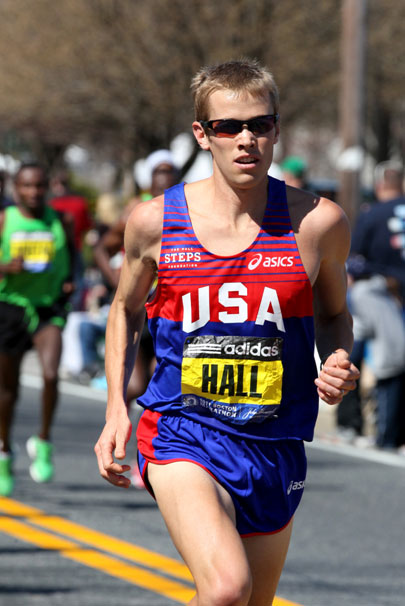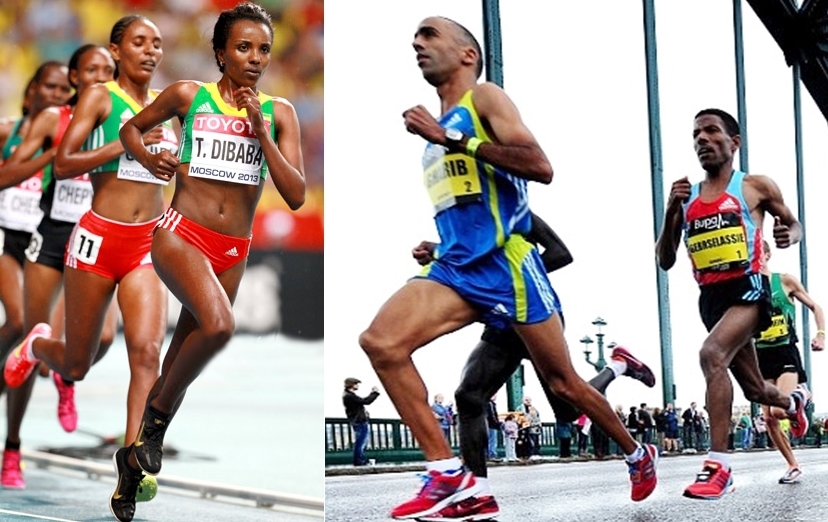In most cases, East African elite distance runners consistently outperform US distance runners.
 With all the technology and research geared towards improving training techniques, you would think we would be the ones outperforming. But, compared to East African distance runners, our performance is declining precipitously.
With all the technology and research geared towards improving training techniques, you would think we would be the ones outperforming. But, compared to East African distance runners, our performance is declining precipitously.
Our Biomechanics versus Their Biomechanics
Don’t be fooled into thinking the biomechanics of East African distance runners is not a paramount factor in their success because it most certainly is.
The running style of many Ethiopian distance runners reflects a barefoot running style. Remember, humans evolved to run barefoot, or in thin, minimalist footwear, and the biomechanics related to barefoot running allows a runner to run efficiently, and injury free.
Let’s compare how we run to how they run:
1. Foot Strike. Most Ethiopian distance runners run with a non-heel strike landing pattern. Most Ethiopian distance runners are forefoot strike runners.
- While many top US distance runners are forefoot, or midfoot strikers, many heel strike as well.
2. Arm Swing Mechanics. Most Ethiopian distance runners show a suppressed arm swing with greater shoulder and torso rotation. The arms and torso combine to move as one unit swaying side to side.

- Many US distance runners restrict their torso and shoulder rotation and typically pump their arms back and forth .
3. Arm Carriage. Arm carriage is much higher, often resting on the front, upper torso, especially in Ethiopian female distance runners whereas arm carriage is often much lower in US distance runners as the wrists rest closer to the hips and alongside the torso.
4. Eye Gaze. Most Ethiopian distance runners position their eye gaze at the ground, not straight ahead like most US distance runners.
Blame the Shoes and Bad Tips on Biomechanics
Unlike most Ethiopian distance runners, US distance runners have always worn running shoes, particularly shoes with excessive padding, control features and a flared heel. However, mounting reports have demonstrated that athletic footwear causes inherent biomechanical impairments that may foster injury.
US distance runners also follow conventional beliefs on biomechanics that describes a running style different from that of Ethiopian distance runners.
- Many US distance runners perform drills that isolate each phase of the gait considered as the ‘proper’ way to run. Drills such as the ABCs of running drill, strengthens neuromotor components to promote ill-advised biomechanics.
Conversely, Ethiopian distance runners do not have a high knee drive, they don’t drive down the swing leg, and most do not bend their elbows at 90 degrees and pump their arms back and forth like a robot when they run.
The Take Home Message
Could it be that conventional biomechanics were formulated to counter the biomechanical impairments caused by conventional footwear? Nonetheless, using unsupported training approaches and wearing inadequate footwear causes US distance runners to come up short.
Standard recommendations on biomechanics restrains the natural motions of the body whereby restraining preferred, natural movements factors into discomfort, poor performance and injury.
If you follow standard biomechanical recommendations and injure, adopting a barefoot running gait is a natural succession to lower discomfort and improve running motion and efficiency.
More From Run Forefoot:
- Forefoot Running Technique vs Orthotics in Correcting Overpronation
- Heel Strike Runners Show Impaired Elastic Behavior in the Arch Due to Footwear with Toe-Springs
- Meb Keflezighi Wins Boston Marathon and Ditching the Heel Strike Helped Him Do It
- Minimalist Running Shoes May Reduce Knee Pain by Reducing Leg Stiffness
You Might Also Like:
- HerbsPro.com
- Injinji Running Socks
- Buy Vibram FiveFingers Footwear at Eastern Mountain Sports
- Lifeline
References:
Lieberman et al., 2010. Foot strike patterns and collision forces in habitually barefoot versus shod runners. Nature, 463, 531-35.
Robbins, SE and Gouw, GJ. 1991. Athletic footwear: unsafe due to perceptual illusions. Med Sport and Exerc, 23(2):217-24.
Bretta Riches
BSc Neurobiology; MSc Biomechanics candidate, ultra minimalist runner & founder of RunForefoot. I was a heel striker, always injured. I was inspired by the great Tirunesh Dibaba to try forefoot running. Now, I'm injury free. This is why I launched Run Forefoot, to advocate the health & performance benefits of forefoot running and to raise awareness on the dangers of heel striking, because the world needs to know.
Latest posts by Bretta Riches (see all)
- Does Foot Strike Really Matter in Running? YES! - 17/04/2024
- Heel Lifts Increase Injury in Runners - 16/04/2024
- Are Minimalist Shoes Good for Seniors? YES! - 14/04/2024

Leave a Reply